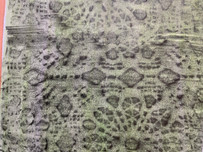

RECYCLING STORIES THROUGH ELECTRONIC DEVICES
Creative Phase Activities
Techniques & Tutorials
MIXING THE FOREIGNER AND THE KNOWN
Creating a collective miniature painting with collage technique
Objectives
1.Enhancing competences in visual perception
2. Recycling and rediscovering cultural and visual heritage
3. Learning about co-creation, working in group
4. Empowering creative processes and visual education
5. Foster self-expression and satisfaction
6. Enhancing cultural diversity and creating cultural encounters
7. Improving skills in the use of digital tools
8. Acquiring new skills in digital content making
Material needed
CRAFT TOOLS:
Acrylic pain, paper and water
Brushes, pencils, pencil sharpener, eraser
Objects for frottage
Pictures taken from a museum, from home, from the street, from a book, etc.
DIGITAL TOOLS:
Smartphones
Time frame
Between 240 and 480 minutes (from 2 to 4 occasions)
Tips
The trainer shall be knowledgeable in the artistic methods and shall have some digital skills in visual content making.
It is a the co-creative exercice to make a collective artwork. It is based on a collection of images, patterns or objects gathered in a museum, at home, form an art catalogue or simply from images taken from the net to which participants will give new personal meanings.
It is particulary recommended for people with middle-eastern origin.
Medieval Iranian and Turkish miniature paintings with their hundreds of small narrative details and with the many different patterns and ornaments appearing within one painting side by side, can be a great inspiration to create collective artworks with the collage technique. It also enables you to work each of you, both independently on your own detail and your pictorial universe, both collectively by putting these elements together and co-crating the narrative.

Based on a collection of photos and objects from the museum, from home, etc. participants create their own personalized ornaments. First each participant work independently on separate papers. Out of these, at the end you will create a collage.
You can use drawing, coloring and painting techniques,
work with colorful pencils or with acrylic paint.










Another idea can be to use the frottage technique.
Here one needs an item that leaves an ornamental imprint e.g. a leaf. Take e.g. the leaf and place it under the paper. Now take a pencil and press it onto the paper underneath the leaf. Slowly, by rubbing it, you will recognize the leaf’s imprint on the paper.
With the same technique, you can get the imprint of any other texture with relief.

Afterwords, your individual ornaments created by drawing, painting or frottage technique will be integrated into the collective composition.






In the Berlin workshop, we decided to create a big Miniature painting since it is an art form that comes from the Middle East.
The participants have seen an enlarged version of a page's detail of the manuscript of Shah Tahmasp, an illustrated copy of the Persian epic poem, the Shahnameh created in the 16th century.

We were inspired to draw a similar one.
We co-created the scene to depict and added the missing narrative elements.
There was a twist in the creation of the women : they decided to change the story of the painting by adding a female figure into the painting. Furthermore, the women added ornaments and items from their own home into the painting and personalised it thereby.














Using Iranian or Turkish miniature painting as a source of inspiration is an opportunity to easily co-create visual narrative artworks as the painting themselves are often composed of separate surfaces comprising very different ornaments and colors juxtaposed to each-other.
It is a feature that can guide you to co-create your final composition.

To find the narrative elements for your collective artwork, you can use digital tools as well.
Get a good reproduction of a miniature painting. Take your phone and walk within the image with your camera. You can either film or take pictures in macro mode as in the Material exploring activity. You can also use the the Stop Motion technique to find or to recreate small stories within the painting.
Persian painting is particular apt for this kind of digital. exercise with all the small stories depicted within just one painting.
Check out for instance, with your camera what or who the naked boy behind the window is looking at.








If the workshop's participants has middle-eastern origin it can also be an opportunity to renew with one's culture of origin.
You can emphasize cultural diversity and mutual influence between cultures by using elements coming from different cultures or modernize the patterns or the scenes or the by featuring contemporary issues by the visual narration.
This contextualization of an ancient art form can of course, become source of humor.
A few ideas from Murat Palta's and Kata Keresztely's works about how to re-contextualize miniature paintings in a contemporary context by giving them new forms and meanings.

Medieval Islamic book paintings can also be inspiring as, just like in the co-creative RE-STOR-E method, these paintings were also co-created and transmit an entirely different vision of artistic creation, interpreted not as an individual but a collective outcome of human creativity.

Recommendations to combine "Mixing the Foreign and the Known"
with other activities: